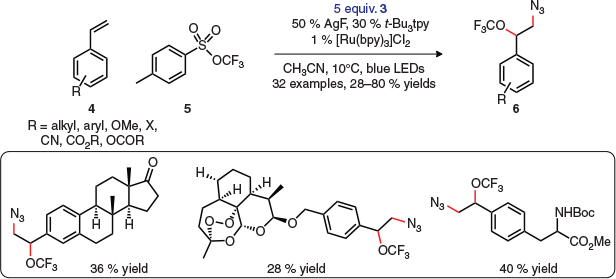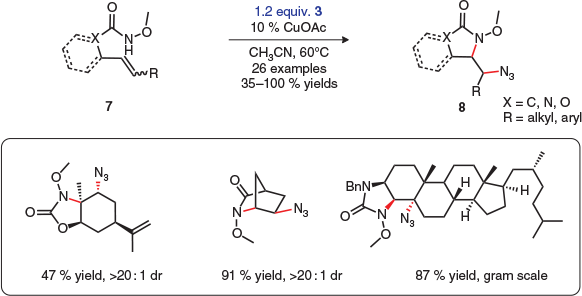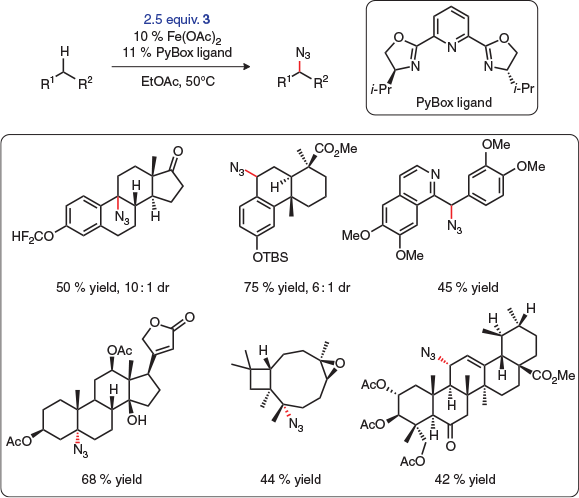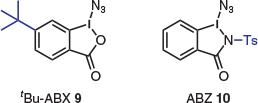Recent Applications of the Zhdankin Reagent in Organic Synthesis*
Angus Olding A B and Curtis C. Ho A B
A B and Curtis C. Ho A B
A School of Natural Sciences – Chemistry, University of Tasmania, Hobart, Tas. 7001, Australia.
B Corresponding authors. Email: angus.olding@utas.edu.au; curtis.ho@utas.edu.au

Angus Olding is about to commence his Chemistry Honours year at the University of Tasmania. He has co-authored five publications from various research projects undertaken during his undergraduate studies. Angus also worked under Associate Professor Tom Maimone while on exchange at UC Berkeley. He intends to pursue a Ph.D. degree in organic synthesis and catalysis. |
Australian Journal of Chemistry 72(8) 646-648 https://doi.org/10.1071/CH19247
Submitted: 1 June 2019 Accepted: 15 July 2019 Published: 13 August 2019
Background
Hypervalent iodine reagents have rapidly become vital synthetic tools in organic chemistry as stoichiometric oxidants and electrophilic sources of various functional groups such as F, CN, and alkynes.[1–3] Many such reagents are now known, with prominent examples such as Dess–Martin periodinane and 2-iodoxybenzoic acid being commercially available. In 1996, the Zhdankin reagent, 1-azido-1,2-benziodoxol-3(1H)-one (3) was first prepared[4] from 1-hydroxy-1,2-benziodoxol-3(1H)-one (1) and trimethylsilyl azide (Scheme 1). This hypervalent iodine compound can also be efficiently prepared from iodosobenzoic acid (2).[5] Compound 3 has been shown to primarily act as a source of radical azide.[5,6] Radical reactivity can be initiated thermally or with a peroxide catalyst. The use of this reagent in synthesis has grown considerably since 2013, which may relate to the rise of photoredox catalysis. The latter methodology allows the generation of radicals under particularly mild conditions. The Zhdankin reagent is frequently employed in tandem with a metal catalyst such as copper[7–12] or iron.[13,14] This article highlights some notable applications of molecule 3 that have appeared since 2016.

|
Results and Discussion
Tang and coworkers reported the photoredox-catalysed azidotrifluoromethoxylation of styrenes with the Zhdankin reagent and arylsulfonate 5 in the presence of AgF (Scheme 2).[15] This atom-transfer radical addition provides an elegant strategy for the installation of trifluoromethyl ethers, and an azide primed for further functionalisation. The authors propose that a putative azide radical is generated from reduction of compound 3 by photoexcited [Ru(bpy)3]Cl2 (a well-established process for 3).[5,7,16] Addition of this radical to a styrene is thought to generate a benzylic radical that is oxidised by [Ru(bpy)3]3+ (bpy = 2,2′-bipyridine) to produce a benzylic carbocation. The latter is intercepted by AgOCF3 (generated from AgF and arylsulfonate 5 in situ)[17] to deliver the product 6. This reaction was applied to a steroid, and artemisinin and amino acid derivatives, demonstrating its capacity to facilitate the late-stage functionalisation of complex molecules.

|
In combination with copper, the Zhdankin reagent has been shown to perform aminoazidations of unactivated alkenes (Scheme 3).[18] Given the prevalence of amines and their derivatives in complex and bioactive molecules,[19,20] such 1,2-diamine derivatives are highly valued. However, poor chemoselectivity has largely limited intermolecular reactions to cases in which both nitrogen substituents within the substrate are the same. Despite these challenges, Wang developed a modular aminoazidation protocol in which a simple copper catalyst facilitates an aminocyclisation. It is suggested that the ensuing alkyl radical is trapped directly with compound 3, ultimately forming the desired azide. This reactivity is distinct from previous reactions in which reagent 3 initiates reactivity rather than terminating it.[21,22] The authors demonstrated their protocol allows for the reaction of both terminal and internal alkenes. The utility of these products was established with efficient gram-scale syntheses of bioactive compounds and an aza-labelled steroid.

|
In addition to radical additions, 3 is also capable of performing C–H azidations. Hartwig and coworkers reported the C–H azidation of a range of structurally diverse natural products (Fig. 1).[23] This was achieved with an iron(ii)/bis(oxazoline) catalyst system in combination with reagent 3. Both benzylic and aliphatic C–H bonds underwent successful azidation, with selectivity controlled by steric and electronic factors within the substrate. The authors hypothesise that a tertiary alkyl radical is generated along with an iron azide intermediate and that the iron complex is directly involved in the C–N bond-forming step.[24] The mild reaction conditions tolerated a wide range of functional groups including basic nitrogens (pyridines), which can poison the catalyst, and ethers, which can be susceptible to C–H abstraction by radicals. This demonstrates the capacity of this methodology to facilitate the rapid late-stage functionalisation of bioactive compounds.

|
Despite the utility of the Zhdankin reagent, like many hypervalent iodine species, it is explosive and shock-sensitive, and injuries have been reported from its use.[25] In an attempt to mitigate these undesirable properties, Waser and coworkers have prepared two analogues of compound 3 with higher molecular weights (Fig. 2). A thorough investigation revealed that these new reagents are more stable than molecule 3 to heat, friction, and shock (marginally in the case of molecule 9). Having established their stability, the competence of these reagents in azidation reactions was also evaluated. tBu-azidobenziodoxolone (9) gave yields comparable with the Zhdankin reagent in the aforementioned azidations by Hartwig and Wang. The reactivity of azidobenziodazolone (10) was limited in some cases by its lower solubility and higher thermal stability, which hindered the generation of azide radicals. Nevertheless, this species still proved to be a viable substitute for molecule 3 in the reactions that were investigated.

|
Conclusions
The Zhdankin reagent is a useful and versatile reagent for azidation chemistry, and it will continue to find applications. Future investigations of this reagent are likely to include the development of safer, more versatile analogues while enabling broader reactivity.
Conflicts of Interest
The authors declare no conflicts of interest.
Acknowledgements
The authors thank Dr Alex C. Bissember for helpful discussions, the RACI for the 2018 Masson Memorial Scholarship Prize, and the University of Tasmania for the 2019 Marshall Hughes Scholarship. This research did not receive any specific funding.
References
[1] A. Yoshimura, V. V. Zhdankin, Chem. Rev. 2016, 116, 3328.| Crossref | GoogleScholarGoogle Scholar | 26861673PubMed |
[2] A. Yoshimura, M. S. Yusubov, V. V. Zhdankin, Org. Biomol. Chem. 2016, 14, 4771.
| Crossref | GoogleScholarGoogle Scholar | 27143521PubMed |
[3] X. Li, P. Chen, G. Liu, Beilstein J. Org. Chem. 2018, 14, 1813.
| Crossref | GoogleScholarGoogle Scholar | 30112085PubMed |
[4] V. V. Zhdankin, A. P. Krasutsky, C. J. Kuehl, A. J. Simonsen, J. K. Woodward, B. Mismash, J. T. Bolz, J. Am. Chem. Soc. 1996, 118, 5192.
| Crossref | GoogleScholarGoogle Scholar |
[5] L. F. Sánchez, E. Merino, C. Nevado, Encyclopedia of Reagents for Organic Synthesis 2017 (John Wiley: Hoboken, NJ).
[6] X. Huang, J. T. Groves, ACS Catal. 2016, 6, 751.
| Crossref | GoogleScholarGoogle Scholar |
[7] P. T. Rabet, G. Fumagalli, S. Boyd, M. F. Greaney, Org. Lett. 2016, 18, 1646.
| Crossref | GoogleScholarGoogle Scholar | 27007454PubMed |
[8] L. Chen, H. Xing, H. Zhang, Z.-X. Jiang, Z. Yang, Org. Biomol. Chem. 2016, 14, 7463.
| Crossref | GoogleScholarGoogle Scholar | 27462802PubMed |
[9] S. Alazet, F. Le Vaillant, S. Nicolai, T. Courant, J. Waser, Chem. – Eur. J. 2017, 23, 9501.
| Crossref | GoogleScholarGoogle Scholar | 28605075PubMed |
[10] L. Li, Z.-L. Li, F.-L. Wang, Z. Guo, Y.-F. Cheng, N. Wang, X.-W. Dong, C. Fang, J. Liu, C. Hou, Nat. Commun. 2016, 7, 13852.
| Crossref | GoogleScholarGoogle Scholar | 28004746PubMed |
[11] Z. L. Li, X. H. Li, N. Wang, N. Y. Yang, X. Y. Liu, Angew. Chem. Int. Ed. 2016, 55, 15100.
| Crossref | GoogleScholarGoogle Scholar |
[12] C. E. Hendrick, K. J. Bitting, S. Cho, Q. Wang, J. Am. Chem. Soc. 2017, 139, 11622.
| Crossref | GoogleScholarGoogle Scholar | 28753007PubMed |
[13] S. Bertho, R. Rey‐Rodriguez, C. Colas, P. Retailleau, I. Gillaizeau, Chem. – Eur. J. 2017, 23, 17674.
| Crossref | GoogleScholarGoogle Scholar | 29143478PubMed |
[14] Y. A. Yuan, D. F. Lu, Y. R. Chen, H. Xu, Angew. Chem. Int. Ed. 2016, 55, 534.
| Crossref | GoogleScholarGoogle Scholar |
[15] F. Cong, Y. Wei, P. Tang, Chem. Commun. 2018, 4473.
| Crossref | GoogleScholarGoogle Scholar |
[16] Y. Wang, G.-X. Li, G. Yang, G. He, G. Chen, Chem. Sci. 2016, 7, 2679.
| Crossref | GoogleScholarGoogle Scholar | 28660040PubMed |
[17] C. Chen, P. Chen, G. Liu, J. Am. Chem. Soc. 2015, 137, 15648.
| Crossref | GoogleScholarGoogle Scholar | 26636720PubMed |
[18] K. Shen, Q. Wang, J. Am. Chem. Soc. 2017, 139, 13110.
| Crossref | GoogleScholarGoogle Scholar | 28825822PubMed |
[19] D. J. Newman, G. M. Cragg, J. Nat. Prod. 2016, 79, 629.
| Crossref | GoogleScholarGoogle Scholar | 26852623PubMed |
[20] L. Li, Z. Chen, X. Zhang, Y. Jia, Chem. Rev. 2018, 118, 3752.
| Crossref | GoogleScholarGoogle Scholar | 29516724PubMed |
[21] B. Zhang, A. Studer, Org. Lett. 2013, 15, 4548.
| Crossref | GoogleScholarGoogle Scholar | 23930944PubMed |
[22] H. Yin, T. Wang, N. Jiao, Org. Lett. 2014, 16, 2302.
| Crossref | GoogleScholarGoogle Scholar | 24735192PubMed |
[23] R. R. Karimov, A. Sharma, J. F. Hartwig, ACS Cent. Sci. 2016, 2, 715.
| Crossref | GoogleScholarGoogle Scholar | 27800554PubMed |
[24] A. Sharma, J. F. Hartwig, Nature 2015, 517, 600.
| Crossref | GoogleScholarGoogle Scholar | 25631448PubMed |
[25] S. Alazet, J. Preindl, R. Simonet-Davin, S. Nicolai, A. Nanchen, T. Meyer, J. Waser, J. Org. Chem. 2018, 83, 12334.
| Crossref | GoogleScholarGoogle Scholar | 30220207PubMed |
* Angus Olding was awarded the 2018 RACI Masson Memorial Scholarship.


